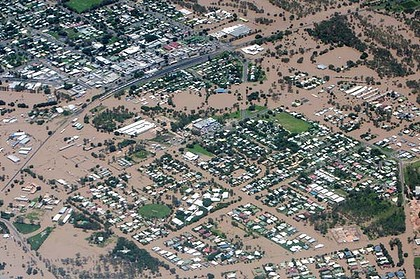Floods cover vast area of northeast Australia
By Bruce Hextall; Editing by Robert Birsel
31 Dec 2010 SYDNEY (Reuters) – Floodwater rose across a vast area in Australia’s northeast on Friday, inundating 22 towns, forcing 200,000 residents out of their homes, and closing a major sugar export port. Flooding has already shut coal mines in Queensland state and its biggest coal export port, forcing miners such as Anglo American and Rio Tinto to slow or halt operations. The worst flooding in about 50 years has been caused by a “La Nina” weather pattern, which cools waters in the eastern Pacific and has produced torrential rain over the past two weeks across northeast Australia. In the southern states of Victoria and South Australia, meanwhile, soaring temperatures and tinder dry conditions have sparked bushfires. Authorities warned of possible “catastrophic” fires if conditions worsened and holiday travelers were asked to prepare evacuation plans. “We’re asking people to have a plan, how they’re going to get to where they’re going … a plan to get away … if a bushfire happens to threaten,” said South Australia rural fire chief Andrew Lawson. Firefighters, helped by cooler temperatures, contained small fires late on Friday, but meteorologists said readings could soar again above 40 degrees Celsius (104 degrees Fahrenheit) in the next few days. In Queensland, authorities warned of rising health risks from floodwaters, along with the danger of crocodiles and snakes in flooded homes. “This disaster is a long way from over,” Queensland state Premier Anna Bligh told reporters. “We now have 22 towns or cities that are either substantially flooded or isolated. That represents some 200,000 people spanning an area that’s bigger than the size of France and Germany combined.” …
Floods cover vast area of Australia’s northeast 
By Adam Carey
January 1, 2011 QUEENSLAND’S flood disaster has affected 200,000 people across more than half the state and crippled its mining sector. The Premier, Anna Bligh, has warned that the worst may be yet to come. ”This disaster is a long way from over,” Ms Bligh said yesterday while touring the flood-affected regions with the Prime Minister, Julia Gillard. Twenty-two towns had been flooded or isolated, Ms Bligh said. Residents in Rockhampton and Condamine were evacuated, some forcibly, from their homes yesterday as the towns braced for the possibility of the worst flooding on record. The town of Emerald was 80 per cent under water after the Nogoa River rose to 16 metres. Police have been deployed in Rockhampton and Emerald to prevent looting. The Queensland Department of Community Safety, co-ordinating the flood response, reported yesterday afternoon that 1260 people had been evacuated from Emerald, 314 from Theodore, and 82 from Condamine. ”There are still many people out of their homes and not able to return,” Ms Bligh said. She said the damage bill would be substantial. ”This recovery from this event is going to require literally billions of dollars from … federal, state and local governments.” The mayor of Rockhampton, Brad Carter, said the city risked running out of fresh food. Supplies such as bread, milk and fresh meat had sold out in many stores, he said, and efforts were under way to ship in more food before roads were cut off. … With more than 90 per cent of QR National’s coal rail system not operating since Monday, and up to 30 coalmines closed due to flooding, estimates have suggested the flooding could reduce gross domestic product by 0.5 per cent, or $6 billion. Queensland Rail yesterday said coal hauls would be reduced until at least next month. And while the Goonyella line was expected to reopen overnight, the potential damage to railroads and roads in flooded areas will not be known until waters recede. Most major ports remain open but there isn’t much to ship.
